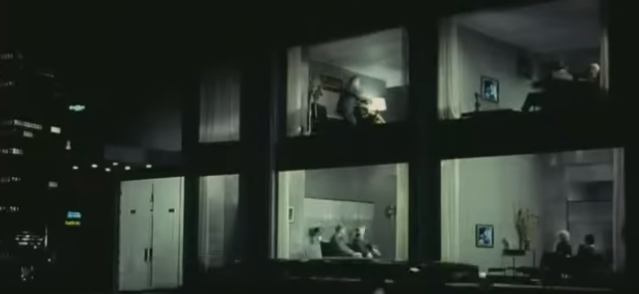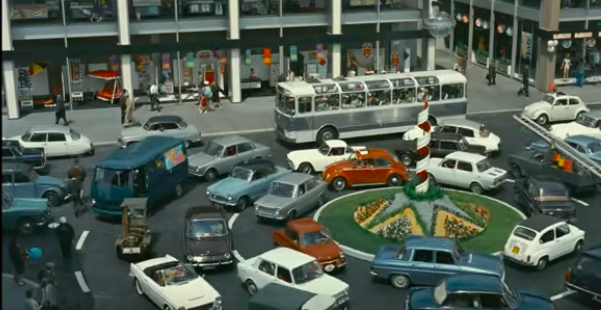
by Fiona Moore
Jacques Tati’s newest movie, first released in 1967 but only recently screened at the Institut Français in London, is a tremendous achievement, dealing with many of the same themes as his earlier movies but in a much subtler and cleverer way. Although the box office has apparently been disappointing, the film is gradually accumulating the critical acclaim it deserves as it makes its way around the world.
The main theme is similar to that of Tati’s earlier comedy Mon Oncle (My Uncle, 1958): the idea that technologically-focused modernity is a superficial, soul-destroying philosophy which is ultimately doomed to failure. Playtime, though, takes a more subtle and arguably less conservative approach.

Playtime movie poster
We find ourselves in a fantasy Paris which is nothing but glass, chrome and concrete office blocks: the famous landmarks of the city, such as the Eiffel Tower and the Arc de Triomphe, are only glimpsed in the reflections of windows. The theme is made clearer when we see a tourist bureau with posters advertising London, Stockholm, and Mexico, each with the same office building and a few superficial details (for instance Routemaster buses and Big Ben) to mark the supposed differences. We are in a futuristic fantasy world where every place is the same and the subtle, playful, unpredictable details have been erased. It isn’t an unhappy scenario: the streets are clean and no one is poor or sick. But the pleasure people take in it is superficial and vapid (a tourist exclaiming at a trade fair that “they even have American stuff!”), and they also don’t seem to know what they are missing.

The Eiffel Tower reflected in a window
The film opens in a building where the viewer is left for a long time with no idea as to its purpose: we see black and chrome sofas, glass frontage, small cubicles. An older couple converse in accented English; nuns pass by, as does a priest, and a nurse with a crying baby. Is it a hospital? A government office? Finally we see a man with suitcases and the nature of the building is revealed: it is an airport. Tati’s cinema persona Monsieur Hulot is changed, having shed his pipe and scarf and adopted a grey coat in place of his trademark brown macintosh, but a variety of other people wander around the story in M Hulot’s costume and are mistaken for him. We see office buildings full of filing cabinets which are revealed, when seen from overhead, to be cubicles; we see little dramas play out in an apartment building where all the walls are glass and face onto the street. At one point two groups of people in adjacent rooms watch the same television programme, completely unaware of this shared experience and unable to come together and commune over their enjoyment.

Apartment living: isolating and atomising?
Unlike the way in which Mon Oncle harked back to a nostalgic imagined past, however, Playtime sees the doom of this conformist, modernist approach as lying in the future. The glass-fronted modernity is fragile and superficial, and falls apart at the slightest pressure, and so can’t cope with the everyday fallibilities of humanity, whether M Hulot, who lopes and skips around an office building and a trade fair subtly creating chaos, or his female counterpart in the story, American tourist Barbara (played by Barbara Dennek), who is constantly getting separated from her tour, or even background characters like a group of glaziers whose window-fitting activities subtly become a dance routine, enjoyed by a crowd of Parisians watching them from the street.

M Hulot observing office work
The film’s message is encapsulated in a long, climactic sequence in a fancy restaurant whose superficial efficiency and organisation is a façade. We see a beautiful oasis of elegant food and décor, but when the backstage areas are revealed, we discover that the restaurant is still being built, that the waiters are swapping jackets to hide stains and damage, that the kitchen is chaos. The introduction of M Hulot breaks the boundary between front and backstage and sends the whole thing into a joyous spiral of anarchy: the glass door shatters, the ceiling decoration falls down, the decorous bossa-nova music turns into wild jazz. The lighting fixtures break. Random people wander in off the street. Chairs fall over. Waiters trip. A plastic sculpture of an airplane melts. A wealthy American businessman declares one section of the room his private bistro and invites tourists and workmen to eat and drink at his expense. A drunk is ejected and walks straight back in. The austere and ordered modernity is undermined from all sides.
 The car carousel makes Paris playful again
The car carousel makes Paris playful again
Afterwards, the patrons walk out into a transformed city, one which still includes the office blocks and grey concrete, but where the cars are now colourful, the buildings hung with bunting, and cheerful shops selling cheeses and scarves have replaced the trade fair. M Hulot buys Barbara a gift but, being unable to give it to her, delegates one of the Hulot impersonators to do it. Tati’s direction wittily turns a roundabout into a carousel, a car mechanic’s shop into a fairground ride. The message is not to destroy technological modernity, but to subvert it, and to find ways of making it joyful and playful. Five stars. Go and see it—if you don’t speak French don’t worry, most of the dialogue is in English and the physical comedy carries the action.

The Green Slime movie poster
From the sublime to the ridiculous! The other film I saw this week is the recently-released SF-horror The Green Slime, a Japanese production filmed in English with American and European actors. The plot involves a spaceman, Jack Rankin, sent up to a space station commanded by the man who has stolen his girlfriend, to lead a mission to destroy an asteroid which threatens Earth. In doing so, however, he and his crew accidentally bring back some of the titular slime which, when exposed to radiation, develops into alien monsters which must be fought while the two men and their love object reconcile their romantic interests.
I give this film more points than most reviewers because of the, possibly unintentional but definitely hilarious, Freudian message: a man’s jealousy over his ex-girlfriend’s new relationship causes him to unleash, through the medium of green slime, one-eyed tubular monsters onto the universe, and it’s up to him to bring them under control again. The modelwork is good and the characterisation unsubtle, giving the series the feel of what might happen if Gerry and Sylvia Anderson decided to work with live actors rather than puppets (as I’m told is soon to be the case), but without the budget of a Century 21 production. Definitely one to watch only when inebriated and in the right company, but very fun under those circumstances; I'm not sure if I was supposed to laugh all the way through it, but I did. One and a half stars.



